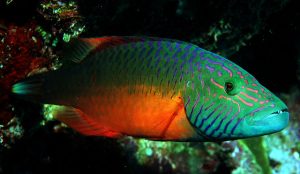Tangs
Arguably the most recognized reef fish in the hobby, tangs are great fish for a large reef. Most tangs reach sizes of 10”+, making them showpieces for large aquariums. Tangs are extremely active fish, spending the bulk of their time cruising around the tank and grazing on rockwork. Most tangs are also great fish for helping control problem algae, as there are very few algaes they won’t eat.
Sohal Tang
Achilles Tang
Sailfin Tang
Blue Tang
Clown Tang (can be a bit bossy)
Kole Tang
Orange Shoulder Tang
Purple Tang
Atlantic Tang
Chevron Tang
Lemon Peel Mimic Tang
Powder Brown Tang
Yellow Tang
Scopas Tang
Angelfish
Another large fish, angelfish are highly sought after in aquariums. Most angelfish are prone to nipping at corals and clams and therefore don’t make good reef dwellers, however there are a few that tend to be reef safe.
Regal Angelfish
Emperor/Imperator Angelfish
Coral Beauty Angelfish (about 1/10 will nip corals)
Fireball Angelfish
Flameback Angelfish
Cherub Angelfish (the smallest of the angels, only getting to be about 2”)
Flame Angel (this fish is an enigma… some are model reef citizens, some eat every coral they can find, and some are perfect for a while and then turn into terrors)
Lamarck’s Angelfish
Watanabei Angelfish
Spotbreast Angelfish
Bellus Angelfish
 Wrasses
Wrasses
Wrasses are some of the most colorful, active fish you can have in a reef tank. Most wrasses will eat common reef pests, such as flatworms, bristleworms, pyramid snails and other parasites, making them not only beautiful but extremely beneficial to aquariums. While the bulk of wrasses are reef safe with respect to corals, not all wrasses make good reef inhabitants as they may eat clean-up-crew members like snails and crabs. When picking wrasses for a reef it is generally recommended to stick with the Fairy Wrasse (Cirrhilabrus) or Sand Wrasse (Halichoeres) genus.
Melanurus (Hoeven’s) Wrasse
Christmas Wrasse
Scott’s Fairy Wrasse
Carpenter’s Fairy Wrasse
McCosker’s Fairy Wrasse
Flame Wrasse
Leboute’s Wrasse
Lineatus Wrasse
Yellow Coris Wrasse
Radiant Wrasse
Exquisite Wrasse
Yellow-Fin Fairy Wrasse
Rabbitfish
Another excellent choice for algae control, rabbitfish are perfect for large aquariums. Generally speaking only one rabbitfish should be kept per tank, but large tanks can sometimes house two or three without much trouble.
Scribbled Rabbitfish
Foxface Rabbitfish
Two-Toned Rabbitfish
Two Bar Spinefoot
Gold Spotted Spinefoot
Magnificent Rabbitfish
Triggerfish
One of the more unique fish out there, triggers are an interesting choice for reef tanks. Most will eat coral, however there is one genus that will usually leave coral alone. As such, trigger options are limited, but owning one definitely sets your tank apart.
Blue Throat Trigger
Sargassum Trigger
Crosshatch Trigger (very rare, commands a high price when available)
Damsels and Chromis
Small, attractive fish that sometimes form schools. Damsels tend to have quite an aggressive nature, however most chromis are more peaceful. Both are extremely hardy and active and perfectly reef safe additions.
Blue/Green Chromis (somewhat likely to school)
Vanderbilt Chromis (very likely to school)
Electric Blue Reef Chromis (not very likely to school, does best in small groups or as a single fish)
Lemon Damsels (the only damsel I would consider in a reef as they are passive, however they stay small)
Black Bar Chromis (will kill other chromis, but fine on its own)
Anthias
By far the best fish for schooling, anthias are very fun to watch in a large aquarium. Most anthias require very specialized diets, however, and are not ideal candidates for most tanks unless you take the time to customize a feeding regiment just for them. Anthias also require several feedings a day because of their high activity levels. There are two species of anthias that adapt well to pellets/flakes and single feedings though.
Bartlett’s Anthias
Lyretail Anthias
Butterfly Fish
Most butterflies will absolutely devour coral; however there are a few that are planktivores and usually leave corals alone.
Pyramid (Zoster’s) Butterfly (somewhat hard to find as availability is seasonal, these are often considered 100% reef safe)
Longnose Butterfly (95% are reef safe)
Long Longnose Butterly (the longer nose cousin of the longnose, these are usually 99.9999999% reef safe)
Copperband Butterfly (85% are reef safe, though they have a reputation for being fine for years then turning on coral)
Gobies and Blennies
I’ve never come across a goby or blenny that isn’t reef safe. Most range from 1” to 8” when full grown. They can be shy, hiding in caves and rockwork, but some are more active than others.
Fang Blennies (the most active blenny family)
Algae/Seaweed Blennies (more cryptic, but great for algae control)
Watchmen Gobies (hide a lot, but very neat fish)
Shrimp Gobies (you will likely never see them, but they are the most uniquely patterened fish in the group)
Oddities
The fish that you sometimes find in reef tanks.
Lionfish (great with coral, will eat any small fish that fits in its giant mouth)
Groupers and Snappers (won’t touch coral but will devour any fish, snail, crab, shrimp or clam that fits in its mouth)
Boxfish and Cowfish (perfectly reef safe but release a toxin if stressed that can kill coral and other fish)
Jawfish (reef safe but dig elaborate tunnels that can cause rockwork to collapse)
Basslets (Hide 90% of the time, but very attractive fish when they’re out)
Psuedochromis (Generally small, colorful fish that are absolute terrors to everything else in the tank. Will pester other fish until they die)

 Wrasses
Wrasses